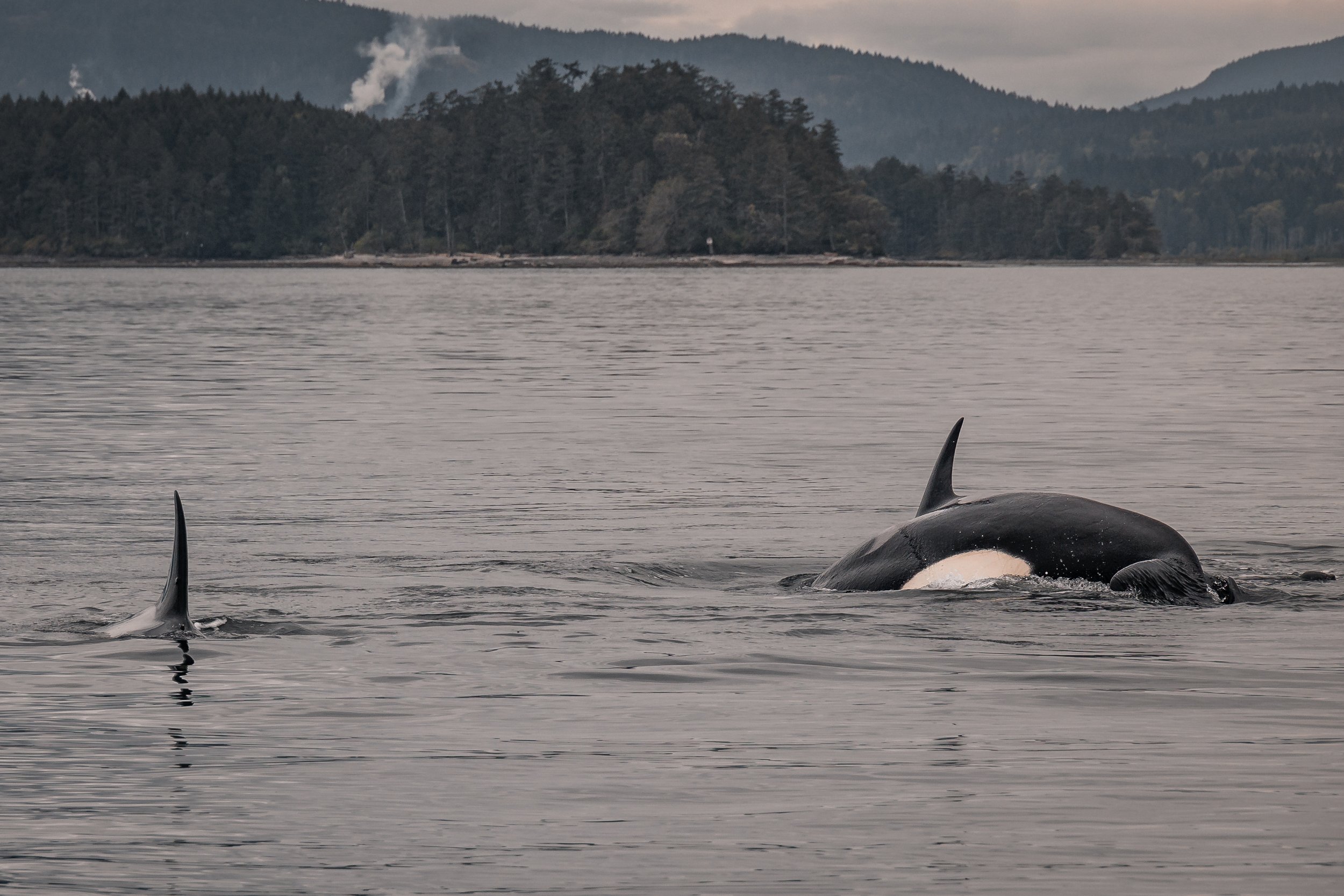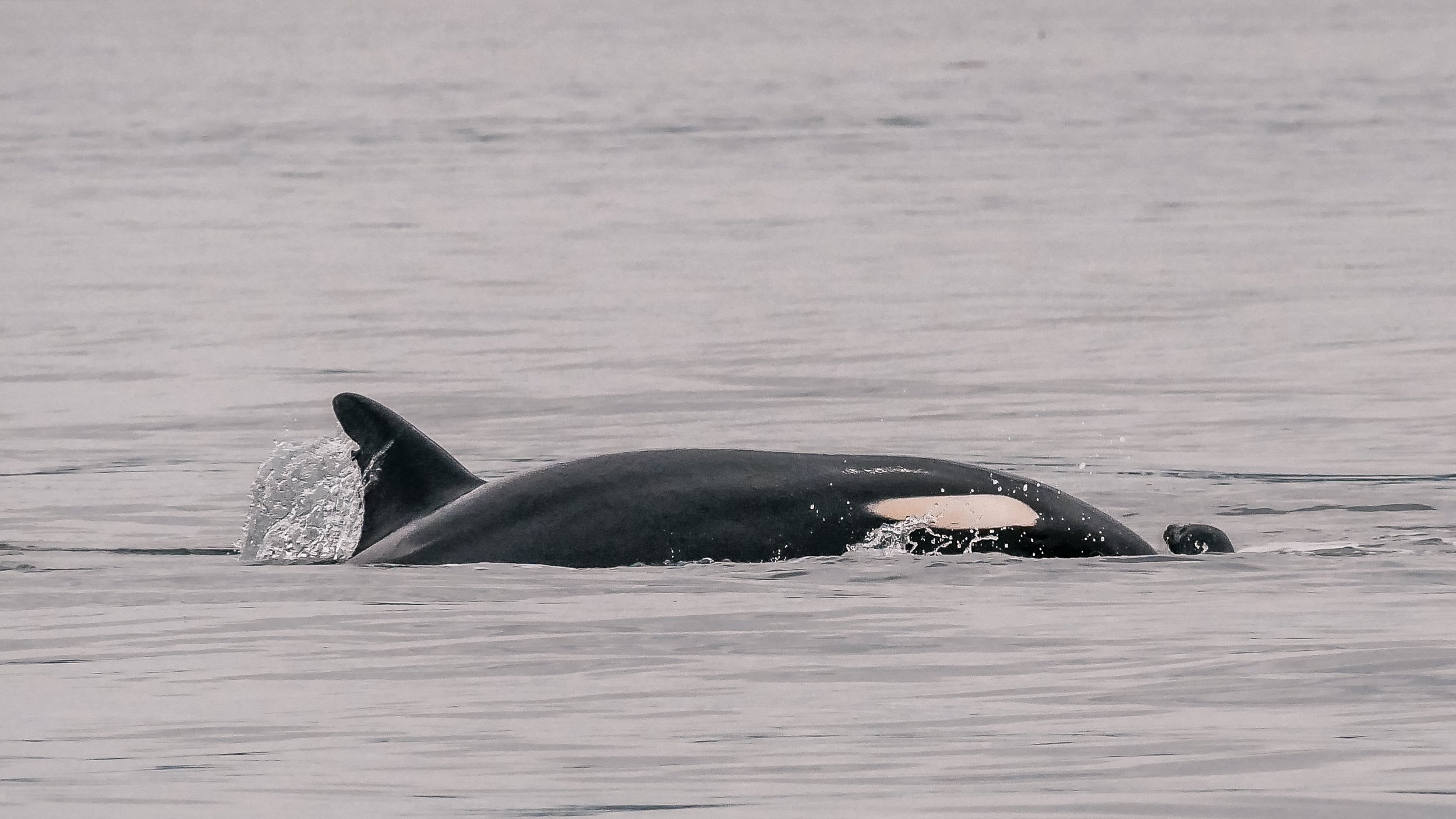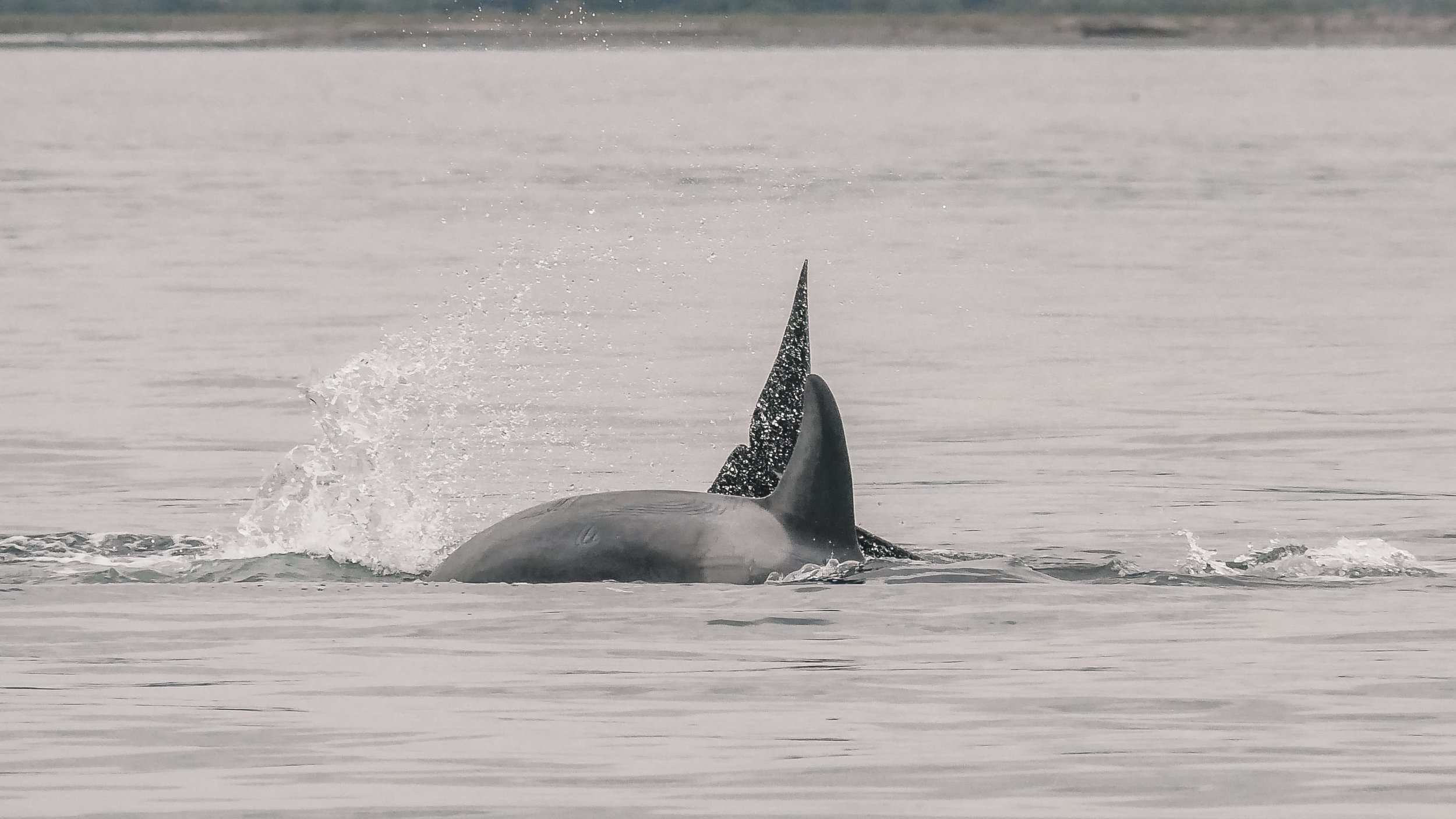May 6th- Lunch date with the T086A's near Chemainus
Both Keta and Kula left the harbour on the 6th with high hopes of finding whales. Kula left the docks first, heading out towards Snake Island to see if they could find a lone whale that had been reported about an hour beforehand. As Keta pushed off the docks and passed Jack Point they heard of a second sighting, a pod of whales coming up through Sansum Narrows. Both of these reports were shore sightings so to maximize chances of finding whales, Keta headed through Dodd Narrows for the second report, while Kula looked for the first reported whale.
Keta headed south through the gulf islands, stopping for some unusual waves near Chemainus. Whatever made the waves never resurfaced, so they continued south, only making it another kilometre or so before they found their actual goal. A blow was seen in the distance, then another. Soon we could make out the small dorsal fins breaking the surface of the flat calm waters. The fins were moving fast, turning and splashing through the water. These whales weren’t having a leisurely journey, they were hunting for lunch.
As soon as we saw the whales were hunting Keta cut the engines, leaving us to idle on the calm waters. When whales aren’t travelling it’s not necessary to have the boat running, especially on flat calm days like this. It’s a much better experience for the passengers, and for the whales, when there’s no noise. Just the sound of the occasional exhale and splash as they chase their quarry through the water.
After a few photos, it was determined we had the T086A’s with us today. This pod has only been seen by us 2 times before, once in 2018 and once very early in 2019 - 3 encounters over 5 years. This pod is comprised of T086A Eider (1988) and her daughters T086A1 Nahanni (2001), T086A3 Tyndall (2011), and T086A4 Akia (2016). Eider sustained injuries to her lower jaw at some point that has left her with a permanent over-bite. This causes her mouth to always be slightly open.
We were still quite a distance from the whales and could have approached closer, but we didn’t want to disturb the action, so we waited and watched eagerly. With our engines off and out of the water, the whales continued their hunt. They popped up slightly closer, the seal now visible with the naked eye. We watched the different members of the pod circling their prey, diving under and around. Tails slapped the water as Tyndall threw herself at the seal, its head visible above the water for a split second before she grabs its tail and drags it under. The water stilled as the whales and seal disappeared below the surface. Everything was quiet and we held our breath. Then they surfaced, right next to the boat. Thankfully the engines were already off and out of the water. Tyndall and her sisters exhaled, floating alongside us, examining the boat and the people on it. Tyndall dove under, followed by one of her sisters. Her mom and other sister surfaced in front. The seal was still missing.
As the whales circled we began to wonder if they had finished their hunt, and then the seal reappeared. It wasn’t at the surface long before one of the whales grabbed it, dragging it under. It reappeared over and over, the whales never letting up. Every time the seal surfaced the whales surfaced, circled, and one would move in to grab it.
Photo by Rebeka Pirker.
Photo by Rebeka Pirker.
T086A3 Tyndall. Photo by Rebeka Pirker.
Photo by Rebeka Pirker.
Breaking the surface! Photo by Rebeka Pirker.
Photo by Rebeka Pirker.
Orca fastfood. Photo by Rebeka Pirker.
This encounter was a perfect demonstration of how relentless and coordinated orcas are. They never gave their prey a chance to rest, or escape. One orca was always circling, blocking any easy escape routes the seal may have thought of, while another family member would circle and drag it under. Orca are excellent pack hunters, with each family member in tune with the others, it will often appear as if they are going to collide, and at the last minute, with seemingly no communication, one will go up and one will go down. They seem to hunt in a pre-choreographed dance.
Watching these whales during times like this often feels like we are watching a performance, especially when they choose to come so close, allowing us even more insight into their magical underwater world. To the whales, however, this was just another day, another lunch, not unlike the meal before, or the one to come.
As other boats arrived on scene, and the whales clearly done with their meal started to put more and more distance between them and Keta, she lowered her engines and started moving on.
At this time Kula was coming in for their chance at seeing the orca. When Keta stopped with the orca Kula was out in the Strait, scanning for other orcas and humpbacks. We had made the decision to keep only one of our vessels on scene with the group at a time, as almost all other whale watching boats in the area were on their way to the orca. We didn’t want to add yet another boat to the mix, so Kula waited until after Keta had departed to take their turn viewing the T086A’s. By this time the pod had finished lunch and began their journey north towards Dodd Narrows. This pod of 4 whales needs about 1200 lbs of food per day to sustain them, and that seal was likely around 150 lbs, not nearly enough to satiate the family. So off they went in search of their next meal. Kula followed along as the pod picked up speed, porpoising from time to time as the continued north along the east coast of Vancouver Island.
Both vessels stopped at Norway Island to view a harbour seal haul-out, getting a good look at the little ‘rock sausages’ resting in the water and on the shore. Harbour seals look so content and sleepy when not being changed by hungry whales. Most of the time they are found laying around, soaking up the sun and quietly grunting at each other. We also stopped at “stinky rocks”, a small unnamed cluster of rocky islands near the north end of Valdes Island. These rocks were dubbed “stinky rocks” after a recent tour, while watching the steller sea lions the winds blew in the right way- or wrong way depending on how you look at it - and our guests got to experience the true Eau de sea lion. The pungent smell had everyone holding their breath. Thankfully today was a pretty windless day, so our guests were unbothered by the sea lion stench.
After almost 4 hours on the water, both boats returned to the harbour with happy guests who got to experience an amazing day on the Salish Sea.
Today’s photos are by Marine Naturalists Cheyenne Brewster, Rebeka Pirker, and Keagan Sjolie.
Looking to experience the Salish Sea and all its wonder? We offer daily tours, currently at 12 noon to see whales and other beautiful wildlife. Starting May 15th we will switch to 2 tours a day at 10:30 am and 3:30 pm.
You have the choice between 2 vessels for your tour:
Open zodiacs provide nearly 360-degree views of the Salish sea, while wearing a warm anti-exposure suit you’re kept warm and dry (within reason) while you cruise through the sea.
On the semi-covered vessel you sit inside a heated cabin with windows to look out from, and while stopped with wildlife can enjoy the view from the back deck of the boat.
Both boats come with a toilet on board, a captain and a marine naturalist to provide you with information on the area and the wildlife you’re viewing.
Both vessels come with a washroom, a captain, and a marine naturalist to answer any of your questions during the tour.
There are 3 ways to book your Salish Sea experience:
Call us at 250-667-5177
Visit our waterfront office at #5 - 90 Front Street Nanaimo
or book directly through our website
Photo by Rebeka Pirker.
Photo by Rebeka Pirker.
Photo by Rebeka Pirker.
T086A Eider. Photo by Rebeka Pirker.
Photo by Rebeka Pirker.
Photo by Rebeka Pirker.
Photo by Rebeka Pirker.
T086A4 Akia. Photo by Rebeka Pirker.
Going down! Photo by Rebeka Pirker.
Photo by Rebeka Pirker.
Checking Keta out. Photo by Rebeka Pirker.
T086A3 Tyndall. Photo by Rebeka Pirker.
T086A3 Tyndall. Photo by Rebeka Pirker.
T086A3 Tyndall - can you see her face and belly in this photo? Photo by Rebeka Pirker.
T086A Eider and T086A4 Akia. Photo by Rebeka Pirker.
Diving down… backwards!. Photo by Rebeka Pirker.
Photo by Rebeka Pirker.
Photo by Rebeka Pirker.
Photo by Keagan Sjolie.
Photo by Keagan Sjolie.
Keta & guests watching the T086A’s. Photo by Rebeka Pirker.
T086A3 Tyndall ‘examining’ a seal. Photo by Cheyenne Brewster.
And…Photo by Cheyenne Brewster.
Gone. Photo by Cheyenne Brewster.
Photo by Cheyenne Brewster.
A car carrier in the Strait. Photo by Rebeka Pirker.
Photo by Rebeka Pirker.
Photo by Rebeka Pirker.
Photo by Rebeka Pirker.
Photo by Rebeka Pirker.
Photo by Rebeka Pirker.
Photo by Rebeka Pirker.
Photo by Rebeka Pirker.
The Gabriola Bluffs. Photo by Rebeka Pirker.










































